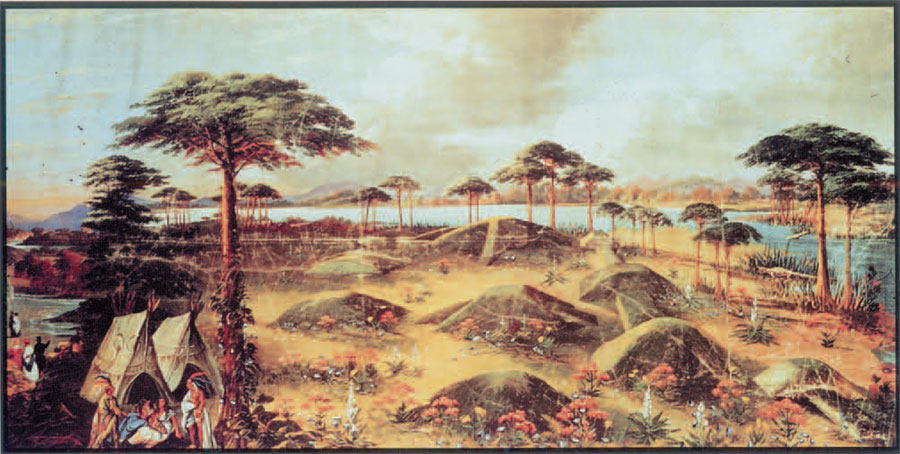
From John Egan, Monumental Grandeur of the Mississippi Valley. Reproduced by permission of the St. Louis Museum of Art.
The history of archaeology is populated by a varied cast of scholars. showmen, adventurers. and charlatans. This article examines the career of a little-known pioneer of American archaeology. Montroville Wilson Dickeson (1810-1882). Dickeson, a Philadelphia physician, conducted extensive excavations of archaeological sites in Louisiana and Mississippi in the 1840s (Figs. 1. 2), amassing a collection of thousands of artifacts. He also acquired. through purchase or trade, material from seventeen other states or territories. More importantly, he contributed to the two great questions debated in 19th-century archaeology: When did the first people arrive in the New World? and, Who had constructed the enormous prehistoric earthworks found along the Ohio and Mississippi rivers?
In 1899 the newly formed Free Museum of Science and Art (now the University of Pennsylvania Museum) acquired Dickeson’s extensive artifact collections, as well as his notes and a massive panoramic painting documenting highlights of his fieldwork. Today. artifacts from these collections remain important components of the American Section’s holdings. They have the potential to inform us about both the prehistory of the southeastern United States and the history of American archaeology. Dickeson research, however, has received little recent attention.
The Early Years of American Archaeology

Courtesy of Annenberg Rare Book & Manuscript Library, University of Pennsylvania
Dickeson was not alone in his interest in North American archaeology. Thomas Jefferson is generally credited with being the first American archaeologist. In 1784, the sage of Monticello conducted excavations at a small prehistoric burial mound or barrow near Charlottesville. Virginia. Jefferson was interested in determining the age of the mound. In his words, That they were repositories of the dead. has been obvious to all; but on what particular occasion constructed, was a matter of doubt” ( Jefferson 1787[1982]; 160).
Other researchers shared Jefferson’s interest. The 19th century saw a growing fascination with America’s prehistoric past. As settlers crossed the Appalachians and headed for the fertile bottomlands of the Midwest. they encountered spectacular earthworks of varied forms. Few of these pioneers were willing to attribute these structures to Native Americans, past or present. The tribes they were familiar with, particularly in the Northeast, were not known to build earthen mounds. Moreover, many Native American peoples were in social disarray, reeling from years of warfare, and their populations were much reduced by disease and poverty. To some observers, they seemed hardly capable of constructing the massive mounds.
Thus there was rampant speculation regarding the identities of the so-called Mound Builders. Phoenicians, Israelites, Vikings Irish Monks, Toltecs from Mexico, and even the conquistador Hernando De Soto were all put forward as possibilities (Silverberg 1968; Williams 1991). Some scholars were, however, more circumspect in their interpretations. Historian Roger Kennedy notes that “…Jefferson, Gallatin, and Washington simply assumed that the people they found in the [Ohio] Valley had been preceded by other Indians who had known more effulgent circumstances. ‘a more populous people’ but not a different one” (1994:236). One other researcher who was willing to attribute these monumental earthworks to indigenous peoples was Montroville Wilson Dickeson.
Young Dickeson
Montroville Wilson Dickeson was born in Philadelphia, Pennsylvania, in 1810. He was raised in Gloucester County. New Jersey, where his family owned a farm in Woodbury (Veit 1997). Even as a youth he had a great interest in the natural sciences and was an inveterate collector, accumulating “rocks, insects, reptiles, and shells” (W. Dickeson 18g9:1). As a teenager he discovered several unique fossils in the Cretaceous marl beds of southern New Jersey. These finds brought him to the attention of the local scientific community. Philadelphia. at the time, was the intellectual center of the young United States. The scholarly institutions in the city included the American Philosophical Society, the Franklin Institute, the Historical Society of Pennsylvania. the Academy of Natural Sciences, the University of Pennsylvania. and Peale’s Museum—America’s first commercially successful museum.
Dickeson studied medicine with Dr. Joseph Parrish in Philadelphia. Parrish was both a distinguished physician and, according to contemporary accounts, an “extraordinarily popular” lecturer on chemistry (Simpson 1859). After completing his studies, Dickeson practiced at the Philadelphia Dispensary. Although he was apparently a successful physician, he decided, after only one or two years of practice, to pursue his other interest—archaeology. His brother William, the author of a posthumous biographical sketch, wrote “[Medicine] was not the only object of his life, the passion for research in the new field of American Archaeology took him to the valleys of the Ohio and the Mississippi where for seven years or from 1837 to 1844 he was a constant traveler” (1899:2-3). Montroville’s own notes indicate that he might better have been described as a constant excavator! Moreover, he was apparently in Mississippi as late as July 1847, for in that year he was excavating on one of John A. Quitman’s plantations, Springfield. There he “found a large Indian mound which contained immense quantities of skulls and bones of natives who he estimated had inhabited the area a thousand years earl ier….News of the archaeological find… soon appeared in several newspapers, one as far away as Houston, Texas” (May 1985:130).
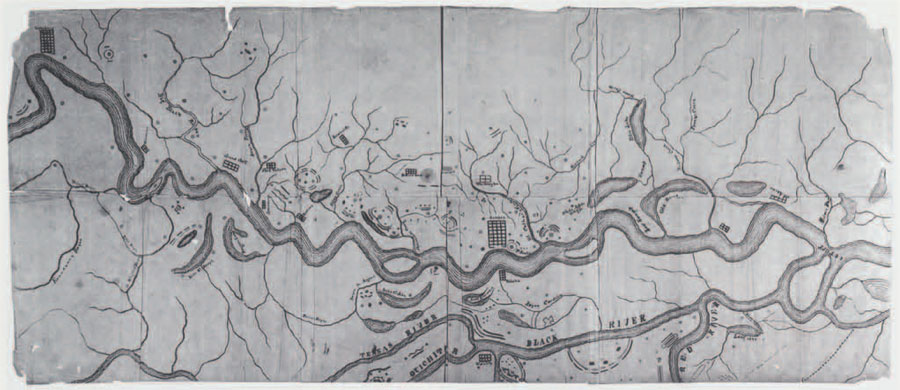
UPM Archives, Dickeson Coll., Special Colls.; Oversize maps, plans, and drawings. UPM neg. 58-142136.
Despite the fact that he was active over 150 years ago. a variety of sources survive which can cast light on Dickeson’s research. One is the previously mentioned sketch written by his brother, who was also a physician and naturalist. Montroville himself penned a series of short articles for the Philadelphia literary magazine The Lotus (Veit 1997:112). In these he presented his conclusions to a public audience, something too few archaeologists find the time to do. However, the most important surviving sources are Dickeson’s original notebook (1848) and an accompanying artifact catalog (n.d.) curated in the University of Pennsylvania Museum Archives. A large and fairly detailed map of Natchez, Mississippi, showing many of the mound groups with which he was familiar, is also held by the Museum (Fig. 3).
According to Dickeson’s notes, he spent seven years in “investigation of the Southern Mound Builders relics in which upward of one thousand tumuli of that long lost and unhistorical people were opened” (1848 : 1). Although he was an archaeological pioneer and might even be described as an archaeological visionary, his reported numbers are often contradictory and may well be exaggerated. For instance, the number of mounds investigated is open to debate. As noted above, one source claims more than one thousand; his best-known publication, the American Numismatic Manual, claims “ten hundred and forty three” mounds (1859:44); and his artifact catalog lists closer to 40 mound groups. While these discrepancies are rather spectacular, there is no question that the hyperbole-prone doctor was actively excavating prehistoric earthworks.
Dickeson- Archaeologist or Antiquarian?
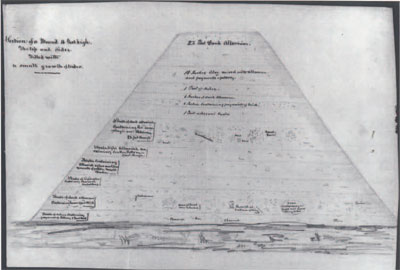
UPM neg. S4-141982
Dickeson was active in an era when there was a resurgence of interest in the ancient past. In northern Europe, by the 18th century, the grand tour had become the capstone of many young gentlemen’s education. The ideas and musings on classical civilization and architecture they brought home from Greece and Rome, as well as the sculptures and other antiquities they decamped with, helped shape architectural design, clothing fashions, and political thought on both sides of the Atlantic. Archaeological excavations at Pompeii had begun in 1738 and have continued unabated to the present day. Goethe, who visited the site in 1787, stated, “Many a calamity has happened in the world, but never one that has caused so much entertainment to posterity” (quoted in Bahn 1996:59). The past was much on the minds of intellectuals in the early 19th century.
Although Dickeson was clearly influenced by the romantic movement, he differed from contemporary antiquarians: he hoped to address specific questions about the societal evolution and history of prehistoric people. The following passage highlights both his romantic sensibilities and his feelings on the importance of archaeology:
the beautiful frescoes of Herculaneum and Pompeii, around them time has indeed flung the silvery mantle of old while he has swept them with decay; but their years may be enumerated; and their circumstances, their authors and the purpose of their origins, together with the incidents of their ruin are chiseled on history’s pages for coming ages. But who shall tell the era of the origin of these venerable earth heaps!—the race of their builders, the purpose of their erection, the thousand circumstances attending their rise, history, and desertion—why now so lonely and desolate? (Dickeson 1848:4)
Dickeson clearly separates the earthen mounds of the Americas from classical ruins. The former, as he notes, are much more enigmatic and cannot be tied to historical records as can Greek and Roman ruins.
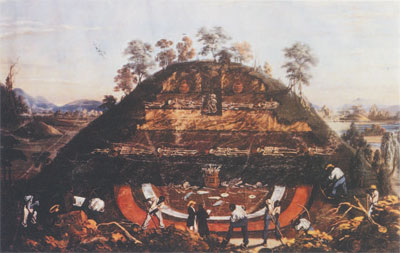
Dickeson carried out extensive excavations in an effort to solve the questions he posed. His techniques were fairly sophisticated for the time. Like Jefferson before him, he advocated using trenches to section mounds, a technique that would remain popular well into the 20th century. More importantly, he took detailed notes on stratigraphy. At a time when many archaeologists saw soil as an impediment to be removed, Dickeson was aware of the importance of soil layers for interpreting the development of sites.
One of the most interesting documents found among his papers is a cross-section of an unidentified mound in Louisiana or Mississippi, with the various layers of soil carefully delineated and described, along with accompanying artifacts (Fig. 4.). A painting done from Dickeson field notes showing a mound with distinct soil strata (Fig. 5) is a common illustration in archaeological texts.
Although his notes are not detailed enough to let us know whether he excavated stratigraphically or simply recognized the importance of strata, his excavations nonetheless predate by some fifty years those of the recognized progenitors of American stratigraphic excavations—W.H. Dail, Max Uhle, and Alfred Kidder. In terms of artifacts, Dickeson had wide-ranging interests. He collected pottery, stone tools, historic artifacts, human skeletal remains, and fossils (Figs. 6 and 7; also see Fig. to). Unlike many of his contemporaries, he noted the waste flakes or debitage generated during the manufacture of stone tools.
Frequently we found a great pile of their chippings among which we find a number of similar pieces and not a single piece that has been finished. This fact led us to suppose that at this place they were chipped into this primitive form, and then by other parties advanced further to the secondary stage, and by more delicate hands finished. (Dickeson 1848 45)
This passage is also noteworthy because it details the stages of stone tool manufacture. Although Dickeson may have been incorrect in assigning the chippings to different workers, his idea that the tools went through several stages of manufacture is shared by modern scholars.
The Mound Builders
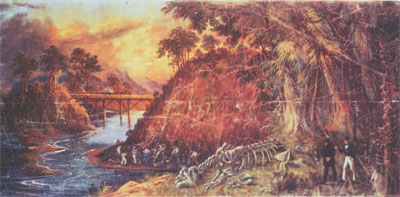
From John Egan, Monumental Grandeur of the Mississippi Valley. Reproduced by permission of the St. Louis Museum of Art.
As previously noted, Dickeson was active at the height of the mound builder controversy. How did he participate? When describing artifacts, he made repeated references to the Egyptians. Greeks, and Romans. In most cases, he did not argue explicitly for transatlantic contact; he simply noted similarities between artifacts. If anything, his writings can be seen as highlighting the accomplishments of Native Americans. not belittling them. Furthermore, he used his observations of Native Americans to provide analogies for the prehistoric features he was uncovering. “The history of our American Aborigines we fear is a sealed book and all that we can judge from at present is analogy” (Dickeson 1848:191).
His writings do allude to one dubious aspect of the mound builder controversy. A facet of the myth that had grown up around these people concerned their supposedly gigantic stature (Silverberg 1968). On occasion Dickeson made reference to large skeletons in the mounds he excavated, statements which could be construed as reflecting the myth. He also referred to the people who constructed the mounds as a lost and forgotten race. This, however, does not necessarily mean that he perceived them as physically different from other Native Americans, just culturally different. Many English writers of the 17th, 18th, and 19th centuries considered their Scottish, Irish, and Welsh neighbors a different “race.” Dickeson apparently did not subscribe to the idea that later “savage tribes” had decimated the mound builders, an idea that was popular with apologists for national expansion.
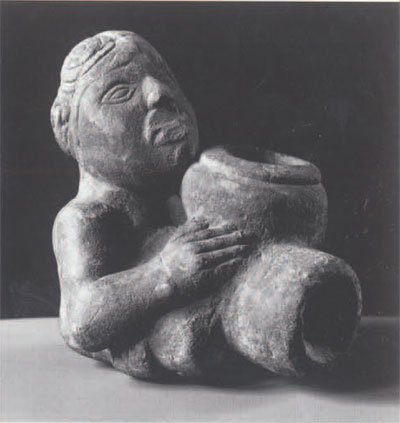
Museum Object Number: 14328, Neg. S8-41147
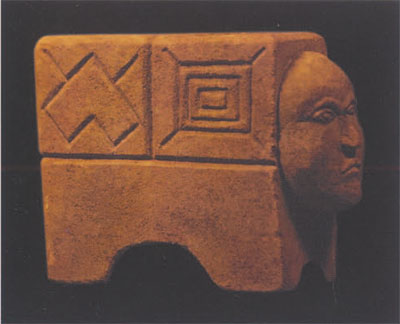
Museum Object Number: 14308 Neg. T35-2175
If this had been the case, then historic Native American populations were as much usurpers on these coveted lands as the colonists. Instead, Dickeson felt that war. disease, and famine had probably led to the demise of the prehistoric societies (1848).
Today, with better excavation and particularly more accurate dating techniques, archaeologists recognize that the mounds reflect not one, but several distinct prehistoric cultural traditions stretching from roughly 2000 BC to AD 1500. They include the Aden a and Hopewell mortuary complexes, as well as the widespread Mississippian culture. Some of the mounds served as burial sepulchers, while many supported temples and still others may have had astronomical functions.
Mastodons
One of Dickeson’s excavations clearly dealt with an occupation predating the mound builders. Excavating near Natchez, Dickeson uncovered a fossilized human pelvis in a stratum of clay underlying the bones of several extinct animals (Fig. 8). The find, which was subsequently known as the Natchez Pelvis, seemed to indicate the great antiquity of human occupation in the New World. Scientists from as far afield as Great Britain visited the site where it was found. Sir Charles Lyell, the father of modern geology, was not convinced by what he saw (Lyell 1873:108). However, later scholars who reexamined the bones concluded that the pelvis and the associated fossils were “substantially oft he same antiquity” (Wilson 1895:725).
In 1926 and 1927, excavations at Clovis, New Mexico, carried out under Jesse Figgens, director of the Colorado Museum of Natural History, recovered fluted spear points in association with extinct bison bones. These finds posthumously vindicated Dickeson belief in the contemporaneity of prehistoric people and the long-extinct animals of the Pleistocene.
Dickeson The Professor
By 1848 Dickeson was back in Philadelphia and seems to have stopped excavating archaeological sites. Perhaps he had generated such a backlog of artifacts that there was no point in excavating more. According to his brother William, “At the old home of his parents, No. 211 Lombard St., the upper story and garret was stuffed with the treasures from the mounds from time to time sent home from his explorations” (W. Dikeson 1899:4.).
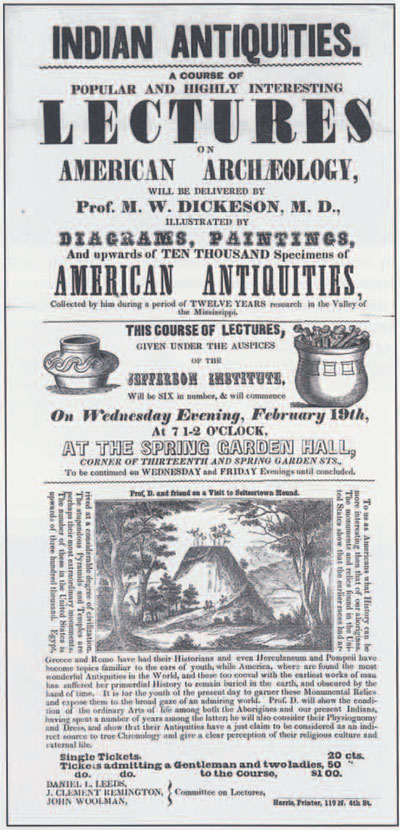
During this time, Montroville returned to his work as a physician and gained a reputation for successful treatments during the cholera epidemics which swept the city in 1848 and 1850 (W. Dickeson 1899). Although no longer actively excavating, he remained deeply interested in archaeology. He commissioned an enormous painting, known as “The Mississippi [or Egan] Panorama,” depicting his excavations and some of the more spectacular sites he had visited. John Egan, an itinerant Irish artist, made the painting from Dickeson Field notes (Veit 1997). Some scenes, such as the opening of a mound on the Feriday Plantation in Louisiana, are quite detailed (see Fig. 5). At the time, panoramas were a popular form of entertainment; they provided a way of recording and sharing particularly interesting journeys or dramatic events. While a half dozen panoramas of the Mississippi were painted between 1845 and 1850, Dickeson’s “The Mississippi Panorama” is the only one which survives (collections of the St. Louis Museum of Art: see City Art Museum of St. Louis 1949).
Dickeson also wrote about and lectured on his excavations (Fig. 9). His collection was displayed at the City Museum in Philadelphia, where he was designated the “Professor of Natu rail Sciences.” Later the artifacts were displayed at the Swain Building, also in Philadelphia, and eventually at the Centennial Exposition in the same city (Fig. 10). They would remain on display in the Exposition’s Memorial Hall from 1876 to 1885 (Mason 1942).
In 1882, following a short illness, Montroville Dickeson died. No obituary notices from Philadelphia newspapers have been found. Two of his sisters inherited the collection, which was-sold in 1899 by his brother William to Stewart Cumin, Director of the University of Pennsylvania Museum. It was an important acquisition and Culin published a description of it in 1900. Since then it has seen only sporadic study and Dickeson himself has lapsed into archaeological obscurity. In 1953. the Mississippi Panorama was transferred to the St. Louis Museum of Art, but the rest of the collection remains at the University of Pennsylvania.
The Invisible Archaeologist
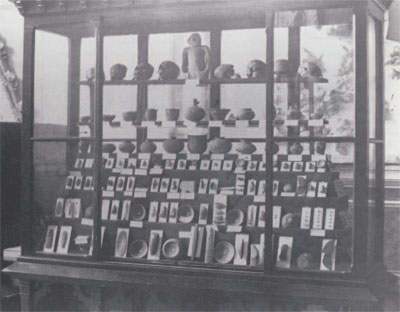
Despite amassing an incredible collection of thousands of artifacts, providing above-average documentation on his excavations, and lecturing widely, Dickeson has been forgotten. Why? His contemporaries Ephraim Squire and Edwin Davis had summed up their research in Ancient Monuments of the Mississippi Valley, (Smithsonian Institution 1848), a well-illustrated monograph that remains widely read today. Dickeson, however, only published his findings locally in serialized form. His one well-known publication, The American Numismatic Manual, is full of conjectures and surmises, particularly regarding Native Americans’ use of stone, clay, and metal tokens as money. It stands in stark contrast with his thoughtful private notebook. He was fond of exaggeration; in fact, at times he seems more showman than scientist. Several of the items in his collection may be frauds, including a galena crystal inscribed with an ankh, the ancient Egyptian sign for life (Fig. II). One must recognize. however, that in the museum field Dickeson was competing with the likes of P.T. Barnum. then the theatrical proprietor of the American Museum in New York City. Dickeson exaggerations seem tame in comparison with Barnum’s famous hokum.
Conclusions
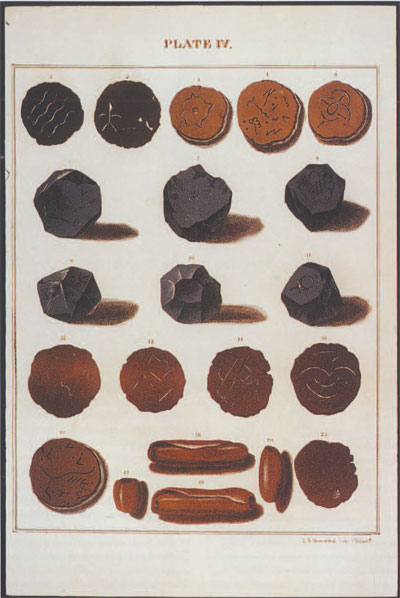
Montroville Dickeson was an innovative and skillful early archaeologist, who recognized and described stratigraphy, noted the stages of stone tool manufacture, and used ethnographic analogies to interpret his sites. His work contributed to the debates on when people initially arrived in the New World. their possible contemporaneity with extinct animals such as mastodons, and the origins and final fate of the mound builders. Many of his hypotheses were right: the first Native American pioneers did arrive in the New World at a time when it was populated by several species of large mammals (known collectively as Pleistocene megafauna), many of which would subsequently become extinct. And yes. later NativeAmericans were responsible for building the earthworks which dotted the central and southeastern portion of the country.
About his brother’s work William Dickeson wrote:
In forming [his] collection he was animated not by an eye for curios—he looked upon antique objects with the eyes of a scholar and the knowledge of a scientist, and in their aggregation deduced many lessons of value to himself and those who came after him, as illustrating the manners and customs of ancient peoples. (1899:5)
His collection and papers, as well as other collections acquired by the University of Pennsylvania Museum in its earlier days, still have much to offer researchers. In the case of Dickeson, they also illustrate the story of one of the more interesting characters in archaeology’s family tree.
